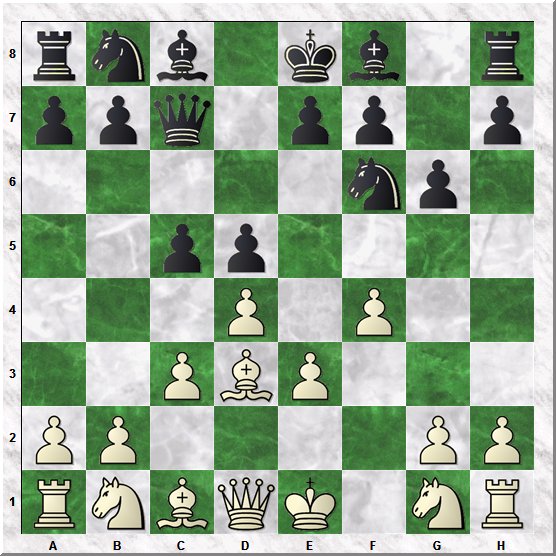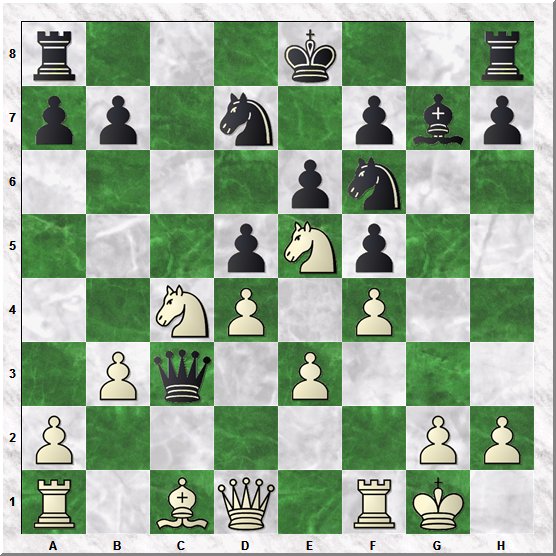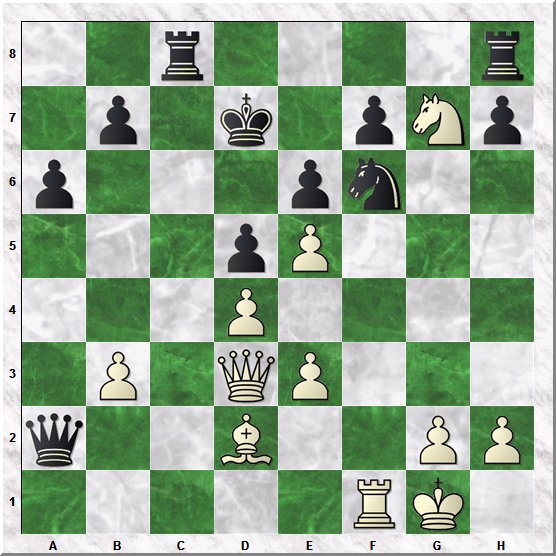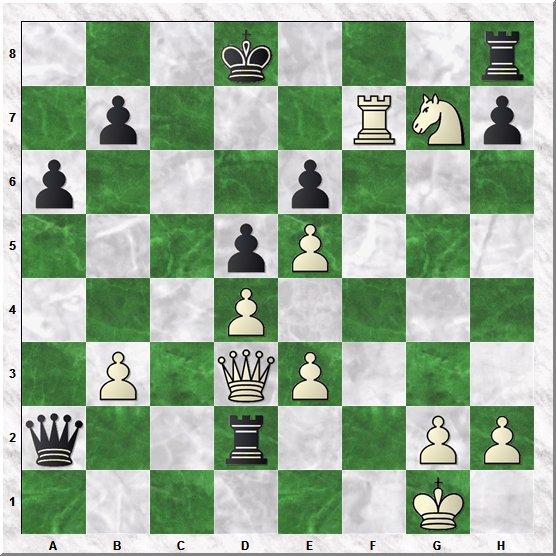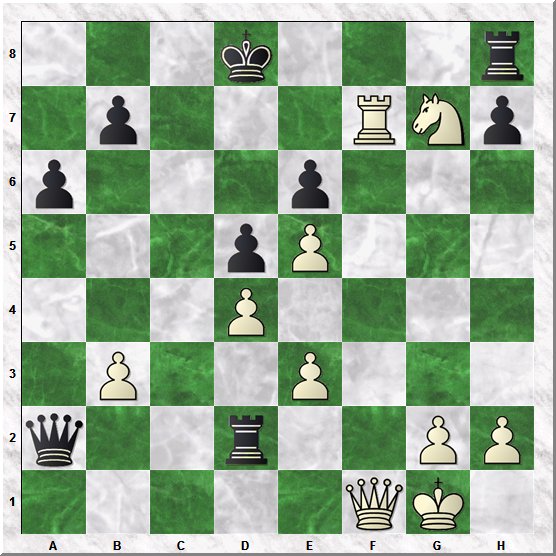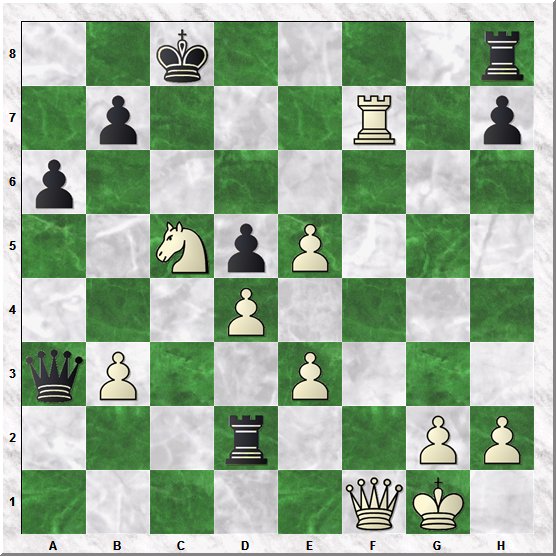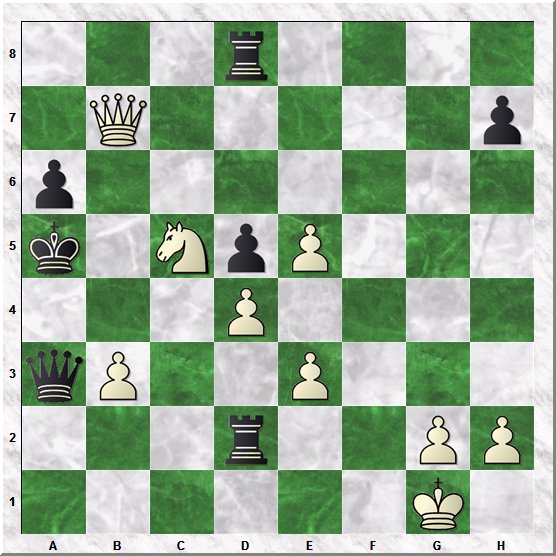All
the |
(Navigation bar
directly below.)
*******
© A.J. Goldsby, 2015.
(All rights reserved.)
****************
Click HERE
to see my
Chess Items.
****************
****************
Buy a book
from Amazon.com
(And help me out as well!)
****************
Click HERE
...
to see a list of the businesses that help to sponsor all of
my chess efforts.
|
|
|
A position from this game was featured as the "Problem of The Day" on the "Chess Games" website. It was such an interesting game that I decided to annotate it. It also features an opening that I have been highly critical of. I once told a student that: "No master would ever use this opening." This game certainly proved me wrong on that account. In the end, I knew that I had to turn this game into a web page. |
|
Click HERE to see an explanation of the symbols that I commonly use when I annotate any chess game. Click HERE to replay this game. (Click HERE to see a "star-dot-pdf" / Adobe copy of my analysis.) Click HERE to see my video channel on the "You-Tube" channel. (Click HERE to see my YT video on this game.) |
Adolf Herzog (2350) - Kurt Petschar (2325)
|
|
|
[A.J.G.]
This was the game that
generated the "Problem of The Day" on the CG website, Wednesday; October 29th, 2014.
(Or Tuesday; October 28th?)
I had a few discussions with several of my students over this game, so I thought
that I would annotate it.
My main motivation for annotating this game was that I told another master (on the phone) that White's attack looked unsound to me. He doubted this and even playfully accused me of talking "out of my hat," (whatever that means). Anyway, the only way to really prove anything ... in a truly scientific manner ... was to turn on the engines and put all of the moves under the microscope.
I had also incorrectly stated
(many times) that the Stonewall was "pure garbage," and that: "no master would ever resort
to using this sorry opening."
(The engines show that for 10-12 moves, the position was completely balanced.
This means that this opening, while not to my tastes most of the time, is as playable as
a lot of other systems.)
1.d4 d5; 2.e3 Nf6; 3.Bd3 c5; (The 4 Principles.)
Black correctly strikes at the center of the chessboard.
[ I don't remember the opponent, but I once
used the Stonewall against an opponent in a G/30 min. ...
back in the days of the "tick-tock" (BHB) clocks.
(It was a piece of pure psychology. I had played this opponent a few times
in blitz, and he used the
Stonewall himself as White, and I wanted to see what happened in the tables were
turned ...
so to speak:
3...e6;
4.c3 c5;
5.f4 Nc6;
6.Nd2 Be7;
7.Ngf3 0-0;
8.0-0 Bd7;
9.Ne5 Qb6!?;
10.g4!? Be8[];
11.g5 Nd7;
12.Qh5!? g6;
13.Qh6 cxd4!?;
14.Rf3!! dxe3?!;
15.Rh3! exd2+;
16.Kg2 Qg1+;
17.Kxg1 d1Q+;
18.Kg2,
"+-" and Black Resigned.
Goldsby - Anonymous. (Mobile?, 1992.)
{The only reason that I still have the score of this game is that I jotted down the moves
<in the margins>
on a page of a pamphlet on the Stonewall, the last chapter was on the Stonewall Attack. I also
remember
that a master - I think it was M. Bury - said my attack was completely unsound.
I had also written the note that 13...P-KB4! was the correct move, and everyone
disputed that as well.
However, it turns out that my sack was sound and that 13...f5; was probably
the best defense for Black.} ]
4.c3 Qc7; (Too quick!?)
Perhaps it is a bit early for Black to bring out the Queen, however, there is nothing essentially wrong with this move, either.
[ A "book line" is: 4...Nc6;
5.f4 Bg4;
6.Nf3 Ne4;
7.0-0 e6;
8.Qe1 Bxf3;
"=" (equal?)
MCO-15; page # 511 ... column # 09.
See the OTB contest: Sergey Kvasov
(1961) - Yerlan Rakhimgaliyev
(2320);
[D00] / Masters Tournament
/ (Aeroflot? Open - "C") / Moscow, Russia / (R2), 2011.
{ 0-1 in just 25 moves.}
*** *** *** *** *** *** *** *** *** *** *** *** *** *** *** *** *** *** *** *** *** *** *** *** *** *** *** *** *** ***
Another try is: 4...e6; 5.f4 Be7; 6.Nf3 0-0; 7.Nbd2 b6; 8.0-0!? Ba6; "~" (unclear)
Black swaps off his bad Bishop, yet this does not quite solve all of his problems.
(Maybe White improves with 8.Qe2!)
E. Deutsch - S. Erenburg; 2004 ISR Champ. {0-1 in 34 total moves.} ]
5.f4 g6;
An interesting position ...
|
|
rnb1kb1r/ppq1pp1p/5np1/2pp4/3P1P2/2PBP3/PP4PP/RNBQK1NR w KQkq - 0 6
White has set up the infamous "Stonewall Attack," which is nothing more than the Stonewall System - of the Dutch Defense for Black ... with colors reversed. The computers show that Black's position is fully playable, the only criticism that I can offer is that White has an extra tempo over the conventional lines where Black plays the Stonewall. (This is the main reason that White's attack works so well.)
For more information on
this system and some brief analysis, see MCO-15, page # 511, and column # 09.
(Plus all the notes that apply to this column.)
For the next series of moves, both sides will develop in a fairly reasonable manner.
6.Nf3 Bg7; 7.0-0 Bf5; 8.Bxf5 gxf5; 9.Nbd2 Nbd7; 10.Ne5 e6; 11.b3 cxd4; 12.cxd4 Qc3!?;
This looks a little risky to me. (Simply castling looked OK for Black.)
[ Much better ... AND much safer was the simple: RR 12...0-0; "=" - Houdini & Fritz. ]
13.Ndc4!?, (hmmm)
Now this is really the only move for White, as his QR is hanging and the KP, (on the e3-square); also "en prise" here.
|
|
r3k2r/pp1n1pbp/4pn2/3pNp2/2NP1P2/1Pq1P3/P5PP/R1BQ1RK1 b kq - 0 13
It is an interesting position, and fully worthy of a diagram here.
[ </= 13.Ba3?! Bf8; "+/" ]
13...Nxe5!?; (Maybe doubtful?)
Black trades material before grabbing the hanging Rook on a1, but this only cements White's grip on the d6-square.
[ Probably better was: >/=
13...Ne4; when the Black
Knight on e4 helps to guard the d6-square.
(White should play 14.Bd2, "+/="
when the engines show that White is probably just a little better.)
*** *** *** *** *** *** *** *** *** *** *** *** *** *** *** *** *** *** *** *** *** *** *** *** *** *** *** *** *** *** *** ***
It would be a mistake for Black to immediately capture the Black Rook on the a1-square, for example:
RR 13...Qxa1?!;
14.Nd6+ Ke7;
15.Qd2!,
"+-" and any good engine will show that Black is lost.
(White has ideas of NxP/f5+, to be followed by Ba3+, winning the Black
Queen.
{For example, after:
15.Qd2 Kxd6?; 16.Ba3+, Black just loses the Q.})
]
14.Nd6+ Kd7; 15.fxe5!?,
Interesting ... but perhaps not the best continuation here for White.
[ The engines seem to prefer 15.Bd2 here for White:
>/=
15.Bd2! Qd3;
16.dxe5 Ne4;
17.Nxe4 dxe4; 18.Bb4!,
"+/=" (Maybe "+/")
when White has a solid advantage in this position. ]
15...Qxa1; 16.Qd3! a6[];
Now this was completely forced.
[
Instead, after any other move, Black would get smashed.
For example: </=
16...Ng4?;
('??')
17.Qb5+ Kd8;
18.Nxb7+ Kc7;
19.Nc5, "+/-"
and Black will get mated in about 7-8 more moves.
(19.Nc5,
Nxe5[]; 20.Qb7+, Kd8; 21.dxe5, Ke8;
22.Qxa8+,
Ke7; 23.Qb7+, Kf8; 24.Qc8+, Ke7;
25.Qd7+,
Kf8; 26.Qd8#.) ]
----> Now the engines show that White should play 17.exf6, with wild complications.
17.Nxf5!? Rac8?!;
This was OK for Black, but the second player had another move (...Bf8!) that was a definite improvement for him.
[
Much better was: >/=
17...Bf8;
18.Ng3 Ng8!;
19.e4 Ne7;
"-/+"
and Black will anchor his Knight on d5 and have a completely winning game.
*** *** *** *** *** *** *** *** *** *** *** *** *** *** *** *** *** *** *** *** *** *** *** *** *** *** *** *** *** ***
It was an error to take the WN on f5, for example:
</= RR
17...exf5?;
18.Qxf5+ Kc6;
19.Qc2+ Kd7; 20.exf6 Bh6;
Black almost has to play this.
(Even worse would be:
</= 20...Bf8?!; 21.Bd2 Qxf1+;
22.Kxf1 Rc8;
23.Qf5+ Kc7;
24.Qxd5 Kb6; 25.Qxf7, "+/-"
when White is winning.)
21.Bd2 Qxf1+;
22.Kxf1 Rac8;
23.Qf5+ Kc6;
24.Qh5 Bf8;
25.Qxf7,
"+/-"
with a won game for White. ]
18.Bd2 Qxa2; 19.Nxg7,
White is doing all that he can here, however the engines clearly show that Black should be winning ... with best play.
|
|
2r4r/1p1k1pNp/p3pn2/3pP3/3P4/1P1QP3/q2B2PP/5RK1 b - - 0 19
Time for a diagram, as the pressure and complications have reached a climax.
[ Or 19.exf6 Bxf6; "-/+" ]
19...Rc2?; (Maybe, really '??')
With one very plausible move, Black throws away the win!
[ Much better was: >/=
19...Ne4;
20.Rxf7+ Kc6;
21.Bb4 Rhg8; "-/+" (Black
is winning.)
and the Black King runs to a7. (On a7, the BK will
be relatively safe.) ]
Now the natural inclination ... according to a few of my {former} students ... would be to play defense and play a move like Rf2.
However, White finds something much better than that!
20.Rxf6! Rxd2?; (W.A.)
Greed ... it gets so many chess players in the end!
[ Black had to play:
>/=
20...Re8[];
("Box.")
which was probably 100% forced. ]
21.Rxf7+ Kd8[]; (Forced.)
This looks bad, but other moves will lose even more quickly here.
|
|
3k3r/1p3RNp/p3p3/3pP3/3P4/1P1QP3/q2r2PP/6K1 w - - 0 22
It is time for another look at the current position, as we have reached another important place in this complicated struggle.
[ Worse was: </= 21...Kc8??; 22.Qc3+ Kb8; 23.Qc7+ Ka8; 24.Qxb7#. ]
22.Qf1!?, (Looked good ...)
This looks like the correct play for White, but it actually should throw away most of the first players' advantage.
|
|
3k3r/1p3RNp/p3p3/3pP3/3P4/1P2P3/q2r2PP/5QK1 b - - 0 22
Now Black has the opportunity to find a move that could save his whole game.
[
Analysis will show that White should have played 22.NxP/e6+ here:
>/= 22.Nxe6+! Ke8;
23.Nc7+ Kd8;
Black doesn't have many good options here.
(
Taking the Rook on f7 will lose by force:
</=
23...Kxf7?; 24.Qf5+ Kg8;
25.Qg5+ Kf8;
26.Ne6+ Ke8;
27.Qd8+ Kf7; 28.Qf6+ Ke8;
29.Qxh8+ Kd7;
30.Nc5+! Ke7;
It no longer matters, all Black can do here is
to
choose the location where his King will be mated.
(
The other way was:
RR 30...Kc6;
31.Qc8+ Kb6; 32.Qxb7+ Ka5;
33.b4#.
with a mate similar to that of the actual game. )
31.Qg7+ Ke8; 32.Qd7+ Kf8; 33.Ne6+ Kg8; 34.Qg7#. )
And now 24.Qf1!, "+-" wins easily for White.
(For all the doubters, the end would look something like
the following continuation:
24.Qf1! Rg8; 25.Ne6+ Kc8;
26.Rf8+ Rxf8;
27.Qxf8+ Kd7; 28.Qf7+ Kc6;
29.Qc7+ Kb5;
30.Qc5#.)
]
22...Qa3??; (Loses!)
Black missed a big chance to to make a major change to the overall course of this game.
[
MUCH
better was: >/=
22...Kc8!;
23.Nxe6 Kb8!;
24.h4,
"~" (Maybe - '+/')
with a position that I
would evaluate as unclear, but the box sees it as being
clearly better for White.
]
23.Nxe6+ Kc8; 24.Nc5, "+-"
Take a look at this position ...
|
|
2k4r/1p3R1p/p7/2NpP3/3P4/qP2P3/3r2PP/5QK1 b - - 0 24
The engines all show that (now) White is winning.
[ RR 24.Rc7+!? ]
Now Black has to find putting his Queen on a5, although White would still be winning.
24...Rd8!?; 25.Rc7+! Kxc7!?;
Black may as well capture ...
but it was probably more prudent to play his King to the b8-square here.
[
The best defense was >/= 25...Kb8[]; however,
White would still have a relatively easy win:
>/= 25...Kb8!;
('[]') 26.Rxb7+! Ka8;
27.Ra7+ Kb8;
28.Rxa6 Qb4;
29.Ra8+! Kxa8;
(Forced?)
Black didn't have many viable alternatives ...
( RR
29...Kc7?!; 30.Qf7+ Kc6;
31.Ra6+ Qb6;
32.Qb7+ Kb5;
33.Qxb6#. )
30.Qa1+ Kb8;
31.Na6+ Kb7;
32.Nxb4,
"+-" Q+N vs. 2R's
when White has an easily won game from here. ]
26.Qf7+ Kb6; 27.Qxb7+ Ka5;
... and Black is toast.
|
|
3r4/1Q5p/p7/k1NpP3/3P4/qP2P3/3r2PP/6K1 w - - 0 28
This was the position for the aforementioned P.O.D.
*******************************************************************************************************************************************************************
White to move and win.
28.b4+! Qxb4; 29.Qxa6#.
So many twists and turns ... it WAS a wild ride, but well worth the effort!
(The analysis clearly shows that both players failed to find the best moves.)
Copyright (c) A.J. Goldsby, 2014. All rights reserved.
1 - 0
The analysis for this page was prepared with the excellent program,
ChessBase
10.0. (I also have CB 11 and CB
12.)
---> My main engine - for this game - was Deep Fritz 14. (I have a lot of
confidence in this engine.)
I also - routinely - check my analysis with the following programs: Houdini 3.0,
Rybka 4, Fritz 13 and Deep Shredder.
The HTML was polished with several different tools and programs, (mostly FP) ... the text was checked for spelling with MS Word.
If you enjoyed this web-page, please e-mail me any comments!
|
Go ... or return ... to my Home Page for this site. Go (or return) ... to my "Annotated Games" (II) Page. Go
... or return ... to my "Best
Games" Page. ******* Copyright
(c) LM A.J.
Goldsby I ******* This
page was first generated in: late
October, 2014. |

